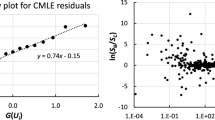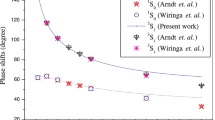Abstract
Using a deformed exponential function and the molecular-orbital theory for the simplest molecular ion, two new analytical functions are proposed to represent the potential energy of ground-state diatomic systems. The quality of these new forms was tested by fitting the ab initio electronic energies of the system LiH, LiNa, NaH, RbH, KH, H2, Li2, K2, H +2 , BeH+ and Li +2 . From these fits, it was verified that these new proposals are able to adequately describe homonuclear, heteronuclear and cationic diatomic systems with good accuracy. Vibrational spectroscopic constant results obtained from these two proposals are in good agreement with experimental data.

Use of the deformed exponentialfunction to improve the accuracyof potential energy curves






Similar content being viewed by others
References
Grisenti RE, Schöllkopf W, Toennies JP, Hegerfeldt GC, Köhler T, Stoll M (2000) Phys Rev Lett 85:2284
Winn JS (1981) Acc Chem Res 14:341
Koperski J (2003) Van der Waals complexes in supersonic beams. Wiley-VCH, Weinheim
Partridge H, Stallcop JR, Levin E (2001) J Chem Phys 115:6471
Tang KT, Toennies JP, Yiu CL (1995) Phys Rev Lett 74:1546
Tang KT, Toennies JP, Yiu CL (1998) Int Rev Phys Chem 17:363
Kleinekathöfer U, Lewerenz M, Mladenović M (1999) Phys Rev Lett 83:4717
Esry BD, Greene CH, Burke JP Jr (1999) Phys Rev Lett 83:1751
Doye JPK, Meyer L (2000) Phys Rev Lett 95:063401
Mathur D (1993) Phys Rep 225:193
Price ST (2003) Phys Chem Chem Phys 5:1717
Steele D, Lippincott ER, Vanderslice JT (1962) Rev Mod Phys 34:239
Koperski J (2002) Phys Rep 369:177
Zavitsas AA (1991) J Am Chem Soc 113:4755
Wei H (1990) Phys Rev A 42:2524
Cvetko D, Lausi A, Morgante A, Tommasini F, Cortona P, Dondi MG (1994) J Chem Phys 100:2052
Pirani F, Brizi S, Roncaratti LF, Casavecchia P, Cappelletti D, Vecchiocattivi F (2008) Phys Chem Chem Phys 10:5489
Alberti M, Castro A, Laganà A, Moix M, Pirani F, Cappelletti D, Liuti G (2005) J Phys Chem A 109:2906
Pirani F, Giulivi A, Cappelletti D, Aquilanti V (2000) Mol Phys 98:1749
Bellert D, Breckenridge WH (2002) Chem Rev 102:1595
Cahill K, Parsegian VA (2004) J Chem Phys 121:10839
Esteves CS, de Oliveira HCB, Ribeiro L, Gargano R, Mundim KC (2006) Chem Phys Lett 427:10
Garcia E, Laganà A (1985) Mol Phys 55:621
Rui-Hua X, Gong J (2005) Phys Rev Lett 95:263
Salviano LR, Esteves CS, de Oliveira HCB, Mundim KC, Ribeiro L, Gargano R (2010) Physica A 389:3604
Mundim KC (2005) Physica A 350:338
de Oliveira HCB, Esteves CS, Gargano R, do Nascimento MAC, Malbouisson LAC, Mundim KC (2008) Int J Quantum Chem 108:2540
de Oliveira HCB, Rangel FC, Esteves CS, Vieira FMC, Mundim KC (2009) J Phys Chem A 113:14691
Rangel FC, de Oliveira HCB, Montel ALB, Mundim KC (2010) Physica A 389:5208
Silva VHC, Aquilanti V, de Oliveira HCB, Mundim KC (2013) Chem Phys Lett 590:201
Aquilanti V, Mundim KC, Elango M, Kleijn S, Kasai T (2010) Chem Phys Lett 498:209
Aquilanti V, Mundim KC, Cavalli S, De Fazio D, Aguilar A, Lucas JM (2012) Chem Phys 398:186
Machado DFS, Silva VHC, Esteves CS, Gargano R, Macedo LGM, Mundim KC, de Oliveira HCB (2012) J Mol Model 18:4343
Rangel FC, Mamiya AA, de Oliveira HCB, Vieira FMC, Mundim KC (2013) J Phys Chem A 117:6622
Borges EP (1998) J Phys A 31:5281
Tsallis C (1988) J Stat Phys 52:479
Borges EP (2004) Physica A Stat Mech Appl 340:95
Lenzi EK, Anteneodo C, Borland L (2001) Phys Rev E 63:051109
Abe S, Okamoto Y (2001) Lecture notes in physics—nonextensive statistical mechanics and its applications, vol 560. Springer, Tokyo
Vila HVR, Luciano AL, Ribeiro Junior LA, Martins JBL, e Silva GM, Gargano R (2012) J Mol Spect 273:29
Neto JJS, Costa LS (1998) Braz J Phys 111:28
Radzig AA, Smirnov BM (1985) Reference data on atoms, molecules and ions. Springer, Berlin
Murrell JN, Farantos SC, Huxley P, Varandas AJC (1984) Molecular potencial energy functions. Wiley, Chichester
Goodisman J (1973) Diatomic interaction potential theory, vol 1. Academic, New York
Acknowledgments
The authors gratefully acknowledge the financial support from the following Brazilian Research Councils: National Council for Scientific and Technological Development (CNPq), Coordenação de Aperfeiçoamento de Pessoal de Nível Superior (CAPES), Fundação de Apoio à Pesquisa do Distrito Federal (FAPDF) and Fundações de Empreendimentos Científicos e Tecnológicos (FINATEC).
Author information
Authors and Affiliations
Corresponding author
Additional information
This paper belongs to Topical Collection Brazilian Symposium of Theoretical Chemistry (SBQT2013)
Electronic supplementary material
Below is the link to the electronic supplementary material.
ESM 1
(PDF 5566 kb)
Rights and permissions
About this article
Cite this article
da Fonsêca, J.E., de Oliveira, H.C.B., da Cunha, W.F. et al. Alternative analytical forms to model diatomic systems based on the deformed exponential function. J Mol Model 20, 2297 (2014). https://doi.org/10.1007/s00894-014-2297-2
Received:
Accepted:
Published:
DOI: https://doi.org/10.1007/s00894-014-2297-2




